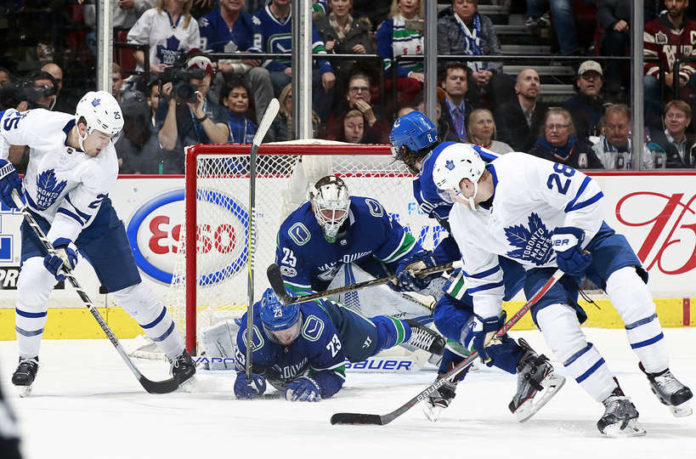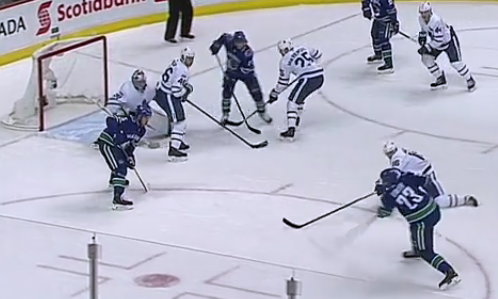
The Maple Leafs dug an early hole before dominating the final 40 minutes and coming up just short in Vancouver on Saturday night.
10 thoughts on the game (and a bit of a look-ahead) below:
1. A fun thing about following this Leafs team: Even when they fall behind – which, for all of the slow starts they’ve experienced lately, really isn’t that often (the Leafs have scored first in 18 of 28 games) – you know there is a huge push coming and that the other team is going to be hanging on for dear life at some point. With the chances and zone time the Leafs generated, it was hard to believe the game was 2-0 Canucks for as long as it was.
The Leafs also created a couple of opportunities to tie the game up when they drew within one late in the third; Auston Matthews didn’t get good wood on a one-timer in the heart of the slot, Connor Brown also whiffed on a one-timer from the hashmarks, and the Leafs couldn’t get on the end of a loose puck in a mad scramble right at the end.
Whether it was a puck bobble at the crucial moment, a good save by Jacob Markstrom, or a great desperation stick/shot block/lay-out by the Canucks defense, it just didn’t fall for the Leafs for basically the entire final 40 minutes. On some nights, that’s just how the cookie crumbles.
2. The Leafs generated 12 high-danger chances to the Canucks’ 6 in this game. In the final 40 minutes, they outshot them 22-7 and out-attempted them 39-16.
Score effects play a huge role with multi-goal deficits, but, overall, the Leafs have controlled 66% of the high-danger scoring chances when trailing this season, which is 1st in the NHL. They also control 59.15% of the shot attempts when playing from behind (3rd in the NHL).
3. Saw Roman Polak catching a lot of flak online after the loss, in most cases for his role in the 2-0 Alex Edler goal. While Polak was an adventure at times in this game (particularly handling the puck/shooting into shinpads at the offensive blue line), he didn’t do much wrong there. Frederik Andersen had enough of a sightline on the puck:

In fact, watching it back, Polak muscled Loui Eriksson out of the way just as he was about to establish a screen position in front of Andersen. This one probably should’ve been stopped.
That said, the Sedins surgically pulled the Leafs apart on consecutive shifts and it seemed like it was only a matter of time before they cashed in.
4. Another good example of Patrick Marleau’s strength on his skates and how heavy he is on his stick, extending possession just before the Morgan Rielly goal late in the third:
I
Just after the end of the clip, the puck moved up high and Rielly wristed the puck in for the JVR goal.
Marleau also created a good scoring chance on his first shift of the game by bulling his way to the puck behind the net. For years, the Leafs used to go into San Jose and you’d wonder why it seemed like Sharks – who didn’t necessarily have a “tough” team, or one that would run opponents over – were winning all of the 50-50 battles. Marleau was one reason why.
5. Another good game from Josh Leivo coming out of the press box. It was a mystery how he didn’t score in this game. He had three quality scoring opportunities, including two point-blank opportunities in the slot. He also drew a penalty late in the first period and generally kept dead plays alive throughout the night, a few times turning them directly into a shot on goal or a shot attempt. Broke a pair of ankles, too:
Leivo out here breaking ankes pic.twitter.com/w3sb0skNfQ
— Flintor (@TheFlintor) December 3, 2017
The fourth line got hemmed in by the Sedins pretty badly in the first half of the first period, but outside of that, they played a strong game and finished as the best line on the team in terms of possession (Dominic Moore: 75% CF, Matt Martin: 71%, Josh Leivo: 67%).
With Babcock far more willing to shake up his lines this season depending on the score, the opponent, and who is going/who isn’t, it’s a shame we haven’t seen Leivo on Matthews’ wing at any point yet.
6. We all saw the o-zone shifts where the Leafs were sliced apart by the trademark Sedin cycle in the first period. This was another good example of how the twins, in a game that’s only gotten faster throughout their time in the league, are still so effective at their advanced age:
I
When it comes to “buying time” or creating time and space in the modern game, we tend to think of speed or explosiveness. The Sedins are so unique and fun to watch because they do it with their minds — by trimming off speed, slowing the game down, and using patience and intuition so effectively.
7. I didn’t think he played poorly last night, but it’s interesting that Jake Gardiner is hovering below 50% CF with a negative CF% relative to his teammates through 28 games. Gardiner has never finished an NHL season with a negative CF% rel – in fact, he’s often shown among the best in the league in that department, particularly when the Leafs were a miserable possession team under Randy Carlyle.
It’s easy to look at Nikita Zaitsev’s numbers with Rielly last year and single him out as the common denominator. Gardiner’s possession numbers haven’t improved in his 100 minutes away from Zaitsev this season, though.
8. What’s interesting is that Gardiner is at 51% CF with a slightly positive relative possession number at home, but is a 46% CF with a -4.05 CF% relative on the road. I’d surmise it has more to do with deployment and level of competition than it does pairing off with Zaitsev specifically. Babcock has moved towards Rielly-Hainsey vs. top competition with better results lately, but obviously has less control over matchups on the road.
The good news (so far) is that the pairing hasn’t cost the Leafs as far as goals/for against thanks to good on-ice shooting/save percentages (1028 PDO). Despite getting outshot 220-188 and out-chanced 218-196, the Leafs have out-scored the opposition 18-15 at even strength with Gardiner and Zaitsev on the ice.
The end goal for Leafs management is to find one more defenceman capable of handling tough minutes well (No easy task, but I’m not talking about a Doughty or Karlsson here). The rest then falls into place, with everyone slotted more comfortably.
9. The bizarre twists and turns in the schedule continue. The Leafs will play one game this week – Wednesday vs. Calgary – before entering a brutal seven-games-in-12 nights stretch that includes two back-to-back sets starting on Saturday.
Both back-to-backs will involve travel in between. In both sets, the Leafs will be playing a rested opponent while tired on the second night.
The schedule is going to get to the Leafs on a few nights in this next stretch and fans would be wise not to overreact.
10. The Leafs will also play a back-to-back coming back from the Christmas break, while nine of their next 12 will be played on the road.
If the Leafs can enter 2018 still in good shape record-wise, they’ll only have to deal with four back-to-backs the rest of the way. They’ll also play 25 games at home versus 17 on the road in the final 42.
The ESPN Relative Power Index – which factors in 25% team winning percentage, 50% opponents’ average winning percentage, and 25% opponents’ opponents’ average winning percentage – puts the Leafs at the eighth toughest schedule to date.
The Leafs could be set up to make a real charge for the division crown if they can make it through the next three and a half weeks relatively unscathed.



































